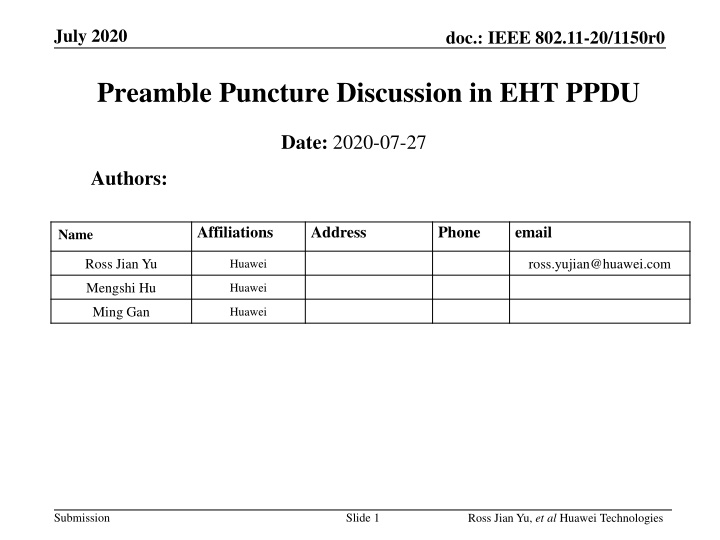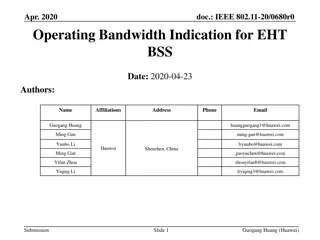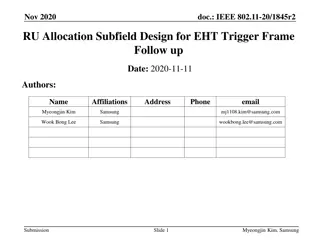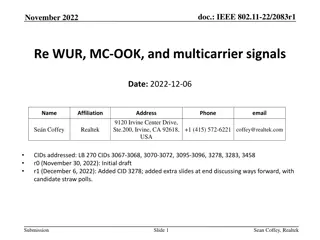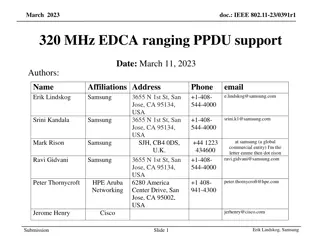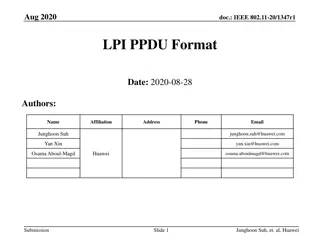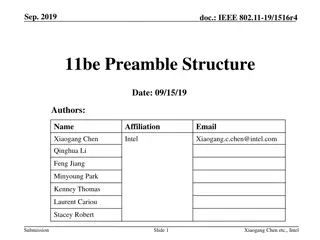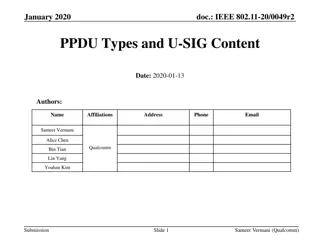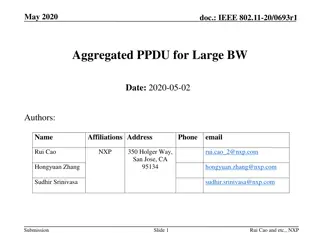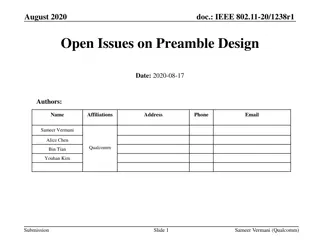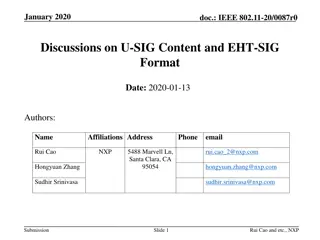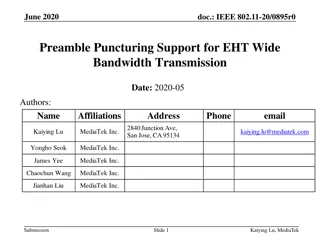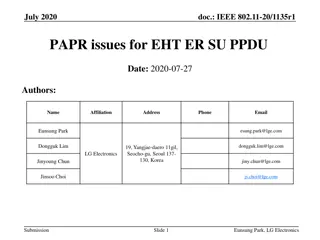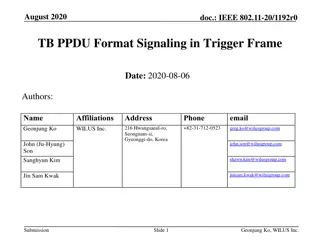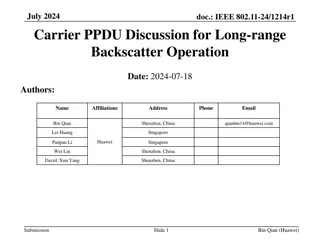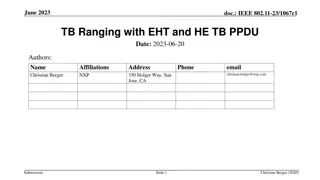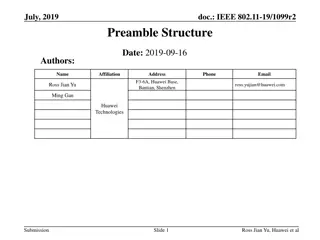IEEE 802.11-20/1150r0 Preamble Puncture Discussion in EHT PPDU
This document discusses the preamble puncture mechanism in IEEE 802.11-20/1150r0 for EHT PPDU transmission. It covers specifics of puncturing channel information, signaling in U-SIG for BW/puncturing, and flexibility in OFDMA and non-OFDMA modes.
Download Presentation

Please find below an Image/Link to download the presentation.
The content on the website is provided AS IS for your information and personal use only. It may not be sold, licensed, or shared on other websites without obtaining consent from the author.If you encounter any issues during the download, it is possible that the publisher has removed the file from their server.
You are allowed to download the files provided on this website for personal or commercial use, subject to the condition that they are used lawfully. All files are the property of their respective owners.
The content on the website is provided AS IS for your information and personal use only. It may not be sold, licensed, or shared on other websites without obtaining consent from the author.
E N D
Presentation Transcript
July 2020 doc.: IEEE 802.11-20/1150r0 Preamble Puncture Discussion in EHT PPDU Date: 2020-07-27 Authors: Affiliations Address Phone email Name Ross Jian Yu ross.yujian@huawei.com Huawei Mengshi Hu Huawei Ming Gan Huawei Submission Slide 1 Ross Jian Yu, et al Huawei Technologies
July 2020 doc.: IEEE 802.11-20/1150r0 Recap 802.11be supports that U-SIG in each 80 MHz shall carry puncturing channel info for at least the specific 80 MHz where it is transmitted. Note: Within each 80 MHz segment, U-SIG is duplicated in every non-punctured 20 MHz. Whether BW/Puncturing info can be different for different 80 MHz is TBD. Whether BW and puncturing info in U-SIG are carried as a combined or a separate field is TBD. [Motion 111, #SP0611-10, [9] and [45]] 802.11be signaling in U-SIG for BW/puncturing information in every non- punctured 20 MHz of an 80 MHz segment shall allow even an OBSS or unassociated device to decode the puncturing pattern of at least the specific 80 MHz that contains the 20 MHz. [Motion 113, [9] and [46]] 802.11be supports BW field which does not include puncturing information. [Motion 112, #SP29, [9] and [46]] Submission Slide 2 Ross Jian Yu, et al Huawei Technologies
July 2020 doc.: IEEE 802.11-20/1150r0 Preamble puncture discussion for OFDMA mode For OFDMA mode (non-compressed mode), the STAs only need the preamble puncture info of the corresponding 80MHz in order to decode EHT-SIG. Then in EHT-SIG, there exists the RU allocation subfields, which indicate the assigned RU/empty RUs across the whole bandwidth . It doesn t matter if one 20MHz subchannel (non-EHT-modulated field) is punctured or not at this stage Flexibility of preamble puncture in OFDMA mode needs detailed discussion. For non-OFDMA mode, there exists up to one hole across the whole bandwidth. Submission Slide 3 Ross Jian Yu, et al Huawei Technologies
July 2020 doc.: IEEE 802.11-20/1150r0 Preamble puncture discussion for non-OFDMA mode For non-OFDMA mode (compressed mode), the STAs need the preamble puncture info across the whole bandwidth in order to decode the data part. Prefer to include preamble puncture info A field in U-SIG, and indicates the puncture info of the corresponding 80Mhz only. For consistency with OFDMA mode Then in EHT-SIG, there exists preamble puncture info B subfield if needed, and indicates the puncture info across the whole bandwidth. When preamble puncture info B subfield exists and how to indicate need detailed discussion. Submission Slide 4 Ross Jian Yu, et al Huawei Technologies
July 2020 doc.: IEEE 802.11-20/1150r0 Preamble puncture indication in U-SIG The following entries are included in preamble puncture indication in U-SIG: Preamble puncture indication A field 80MHz Description in the corresponding Notes 0 1111, no puncture in the corresponding 80MHz, with puncturing in other 80MHz Applied only when BW>80MHz, additional puncture info is needed 1 X111 No additional preamble puncture info needed even for non-OFDMA case 2 1X11 3 11X1 4 111X 5 XX11 6 11XX 7 No puncture across the whole bandwidth Applied to all BW No additional preamble puncture info needed even for non-OFDMA case Submission Slide 5 Ross Jian Yu, et al Huawei Technologies
July 2020 Preamble puncture indication in EHT-SIG doc.: IEEE 802.11-20/1150r0 For non-OFDMA, when does preamble puncture indication B subfield exist and how to indicate have several options: Options When does preamble puncture indication B subfield exist how to indicate in preamble puncture indication B subfield Pro Con Opt1 Exist except the case when preamble puncture indication A field in U-SIG indicates 7 (No puncture across the whole bandwidth) Indicate preamble puncture info in the other one or three 80MHz segments except the corresponding 80MHz Save overhead for some scenarios Different puncture info/existence of puncture info in different 80MHz segments Opt2 (preferre d) Exist except the case when preamble puncture indication A field in U-SIG indicates 7 (No puncture across the whole bandwidth) Indicate preamble puncture info across the whole bandwidth Same puncture info in different 80MHz segments Overhead of preamble puncture info exists for most of the cases Submission Slide 6 Ross Jian Yu, et al Huawei Technologies
July 2020 Preamble puncture indication in EHT-SIG doc.: IEEE 802.11-20/1150r0 Following Opt2, for non-OFDMA, and when preamble puncture indication A field in U-SIG doesn t indicate 7, there exist preamble puncture indication B subfield in EHT-SIG common. The contents of preamble puncture indication B subfield include: Bandwidth (MHz) Preamble puncture indication B Description in the corresponding 80MHz Aggregated Bandwidth 160 0 X111 1111 996+(484+242), 140 MHz (8 options) 1 1X11 1111 2 11X1 1111 3 111X 1111 4 1111 X111 5 1111 1X11 6 1111 11X1 7 1111 111X Submission Slide 7 Ross Jian Yu, et al Huawei Technologies
July 2020 Preamble puncture indication in EHT-SIG doc.: IEEE 802.11-20/1150r0 Following Opt2, for non-OFDMA, and when preamble puncture indication A field in U-SIG doesn t indicate 7, there exist preamble puncture indication B subfield in EHT-SIG common. The contents of preamble puncture indication B subfield include: Bandwidth (MHz) Preamble puncture indication B Description in the corresponding 80MHz Aggregated Bandwidth 320 0 XX11 1111 1111 1111 3*996+484, 280MHz (8 options) 1 11XX 1111 1111 1111 2 1111 XX11 1111 1111 3 1111 11XX 1111 1111 4 1111 1111 XX11 1111 5 1111 1111 11XX 1111 6 1111 1111 1111 XX11 7 1111 1111 1111 11XX Submission Slide 8 Ross Jian Yu, et al Huawei Technologies
July 2020 Preamble puncture indication in EHT-SIG doc.: IEEE 802.11-20/1150r0 Following Opt2, for non-OFDMA, and when preamble puncture indication A field in U-SIG doesn t indicate 7, there exist preamble puncture indication B subfield in EHT-SIG common. The contents of preamble puncture indication B subfield include: Bandwidth (MHz) Preamble puncture indication B Description in the corresponding 80MHz Aggregated Bandwidth 320 8 XXXX 1111 1111 1111 3*996, 240MHz (4 options) 9 1111 XXXX 1111 1111 10 1111 1111 XXXX 1111 11 1111 1111 1111 XXXX Submission Slide 9 Ross Jian Yu, et al Huawei Technologies
July 2020 Preamble puncture indication in EHT-SIG doc.: IEEE 802.11-20/1150r0 Following Opt2, for non-OFDMA, and when preamble puncture indication A field in U-SIG doesn t indicate 7, there exist preamble puncture indication B subfield in EHT-SIG common. The contents of preamble puncture indication B subfield include: Bandwidth (MHz) Preamble puncture indication B Description in the corresponding 80MHz Aggregated Bandwidth (MHz) 320? 12 XXXX XX11 1111 1111 2*996+484, 200MHz 12 or 24 options? 13 XXXX 11XX 1111 1111 14 XXXX 1111 XX11 1111 15 XXXX 1111 11XX 1111 16 XXXX 1111 1111 XX11 17 1111 1111 11XX XXXX 18 XX11 1111 1111 XXXX 19 11XX 1111 1111 XXXX 20 1111 XX11 1111 XXXX 21 1111 11XX 1111 XXXX 22 1111 1111 XX11 XXXX 23 1111 1111 11XX XXXX 24 XXXX 1111 1111 XXXX 2*996, 160MHz 0 or 1 or 4 options? Submission Slide 10 Ross Jian Yu, et al Huawei Technologies
July 2020 doc.: IEEE 802.11-20/1150r0 Preamble puncture discussion summary for non-OFDMA A summary of non-OFDMA case, no preamble puncture indication part B subfield in EHT-SIG is needed for BW<=80MHz; Following Opt2, no preamble puncture indication B subfield is needed when preamble puncture indication A field in U-SIG indicates 7 (No puncture across the whole bandwidth). Following Opt2, 8 entries are needed for BW=160MHz; 24~40 entries are needed for BW=320MHz. In total, 32~48 entries are needed for all supported bandwidth. So 5~6 bit is needed with a different table per BW; 5~6 bit is needed if a unified table regardless of 160/320Mhz BW. Submission Slide 11 Ross Jian Yu, et al Huawei Technologies
July 2020 doc.: IEEE 802.11-20/1150r0 Preamble puncture flexibility for OFDMA The next topic is about preamble puncture flexibility discussion. There are different options regarding flexibility for OFDMA transmission: Opt1: only one hole across the whole bandwidth, same as non-OFDMA case Opt2: supports up to one hole per 80MHz segments, if punctured, the puncture pattern of each segment shall be one of the following:X111 X111 1X11 11X1 111X XX11 11XX Opt 2 is preferred, doesn t add additional complexity to the STA side. Submission Slide 12 Ross Jian Yu, et al Huawei Technologies
July 2020 doc.: IEEE 802.11-20/1150r0 Straw Poll #1 Do you agree to add the following text in the TGbe SFD: In U-SIG field of an EHT PPDU that is not an EHT TB PPDU, there exists a preamble puncture indication A field, which indicates the preamble puncture information of the corresponding 80MHz. Submission Slide 13 Ross Jian Yu, et al Huawei Technologies
July 2020 doc.: IEEE 802.11-20/1150r0 Straw Poll #2 Do you agree to add the following text in the TGbe SFD: The preamble puncture indication A field includes the following indications: Preamble puncture indication A Description in the corresponding 80MHz 0 1111, no puncture in the corresponding 80MHz, with puncturing in other 80MHz 1 X111 2 1X11 3 11X1 4 111X 5 XX11 6 11XX 7 No puncture across the whole bandwidth Submission Slide 14 Ross Jian Yu, et al Huawei Technologies
July 2020 doc.: IEEE 802.11-20/1150r0 Straw Poll #3 Do you agree to add the following text in the TGbe SFD: There exists no preamble puncture indication in EHT-SIG for an OFDMA transmission. Submission Slide 15 Ross Jian Yu, et al Huawei Technologies
July 2020 doc.: IEEE 802.11-20/1150r0 Straw Poll #4 Do you agree to add the following text in the TGbe SFD: There exists a preamble puncture indication B subfield in EHT-SIG for a non-OFDMA transmission except when preamble puncture indication A field in U-SIG indicates 7 (No puncture across the whole bandwidth). There exists no preamble puncture indication B subfield in EHT-SIG for a non-OFDMA transmission when preamble puncture indication A field in U-SIG indicates 7 (No puncture across the whole bandwidth). Submission Slide 16 Ross Jian Yu, et al Huawei Technologies
July 2020 doc.: IEEE 802.11-20/1150r0 Straw Poll #5 Do you agree to add the following text in the TGbe SFD: Regarding preamble puncture flexibility for OFDMA, supports up to one hole per 80MHz segments. If punctured, the puncture pattern of each segment shall be one of the following:X111 X111 1X11 11X1 111X XX11 11XX Submission Slide 17 Ross Jian Yu, et al Huawei Technologies
July 2020 doc.: IEEE 802.11-20/1150r0 Straw Poll #6 Do you agree to add the following text in the TGbe SFD: The preamble puncture indication B subfield includes the indications as listed in slide 7 to 10. Note: different table for 160Mhz and 320MHz bandwidth Submission Slide 18 Ross Jian Yu, et al Huawei Technologies
July 2020 doc.: IEEE 802.11-20/1150r0 References https://mentor.ieee.org/802.11/dcn/20/11-20-0566-46-00be-compendium-of- straw-polls-and-potential-changes-to-the-specification-framework- document.docx, Edward Au, Huawei https://mentor.ieee.org/802.11/dcn/20/11-20-0285-05-00be-su-ppdu-sig- contents-considerations.pptx, Wook Bong Lee, Samsung Submission Slide 19 Ross Jian Yu, et al Huawei Technologies
